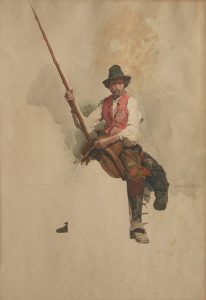Biography

MACCARI Cesare, painter (Siena 1840 – Rome 1919). Student of the sculptor Vestri, he then enrolled in the Sienese Academy of Fine Arts (1855). Committed to studying sculpture, he enters Sarocchi’s studio, until Luigi Mussini, noting his unfinished potential, convinces him to devote himself to painting. During the seven years of the course, he learned from the master the secrets of the purist technique that earned him the prize for the painting Leonardo that portrays the Mona Lisa in 1863. The success of the painting brought him a sudden notoriety in Siena, so much so that the Marquis Nerli commissioned him to decorate the chapel of his home in Quinciano.
In 1866 the retired Biringucci wins (with the painting The last moments of Lorenzo the Magnificent), thanks to which he can go to Umbria for study and then to Rome and Florence (1868) from where he sends to Siena, as the final essay by the retired Vittoria Column meditating on a madrigal by Michelangelo.
Having settled in Rome, he frescoed the church of the SS: Sudario, owned by the royal family, on behalf of the rector of the Piedmontese chapter. He works a lot for Italian and foreign merchants (including the famous Goupil) with pleasant genre paintings poised between the romantic realism of Morelli and the sought-after virtuosity of Fortuny.
In 1878 he was present at the Universal Exposition of Paris with the fresco Deposition du Pape Silvère, re-proposed with an oil version at the Turin National Exposition of 1880.
From this moment the big public commissions begin. In 1880 he won the competition launched by the Ministry of Education to fresco the Senate’s representative hall, beating Cesare Mariani by measure who, a few years earlier, had won the commission to always fresco the Palazzo delle Finanze in Rome. On the walls Maccari paints (1882-1888) some of the episodes that had made the Senate of ancient Rome famous (The stories of Appio Claudio, Marco Papirio and Curio Dentato, as well as Cicero while pronouncing the indictment against Catilina).
In 1884 he was then commissioned by the Municipality of Siena to fresco two episodes on the walls of the Vittorio Emanuele II Monumental Hall in the Palazzo Pubblico. The episodes chosen for Maccari are Vittorio Emanuele II receiving the plebiscite of the Romans in Florence and the transport of the body of Vittorio Emanuele II to the Pantheon (which replaces the primitive equestrian figure of the king that the painter had not liked), and are performed between 1885 and 1887.
Follow the frescoes for the courtroom of the Palazzo di Giustizia (1900-1909), with the stories of Justinian
From 1888 to 1895 he also worked on the decoration of the dome of the Sanctuary of Loreto and, until 1907, on the fourteen episodes of the drum.